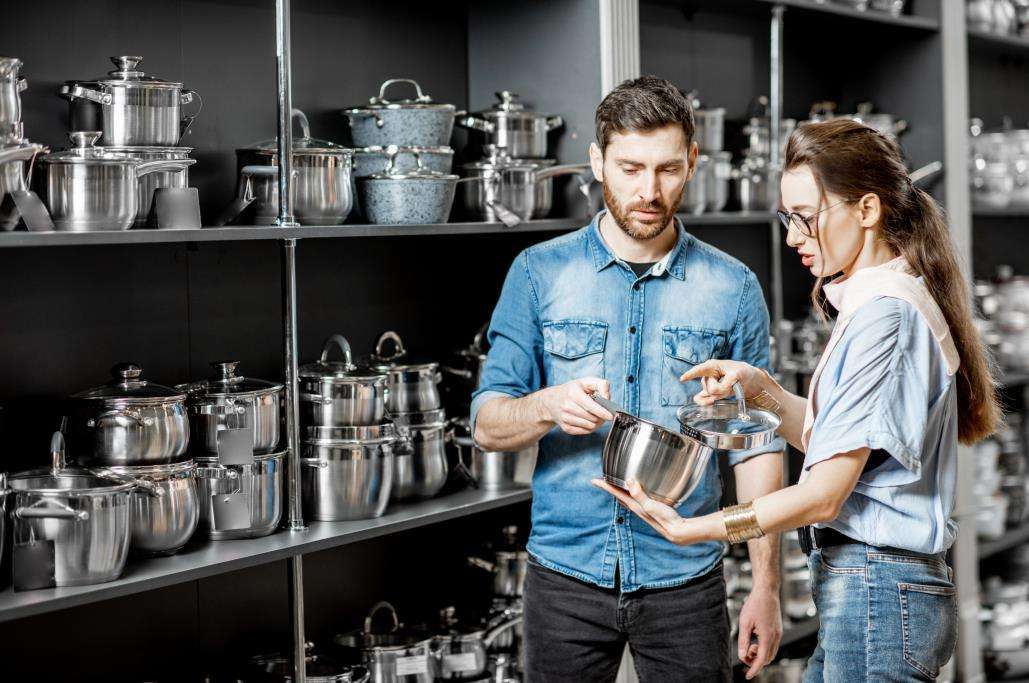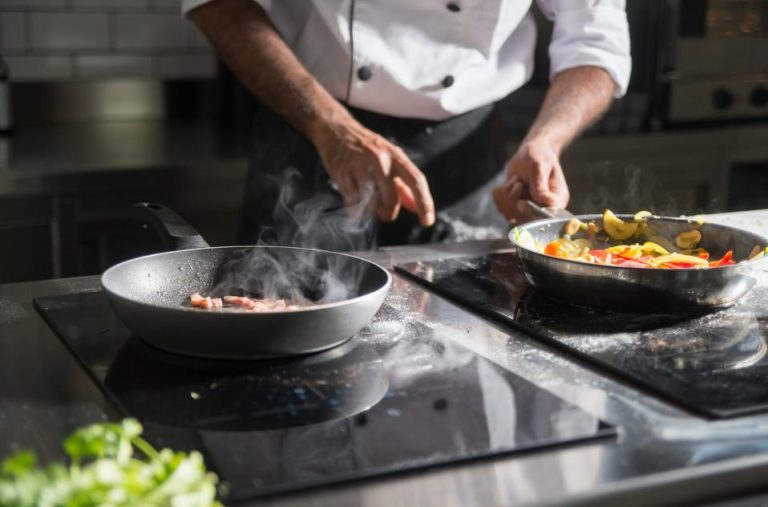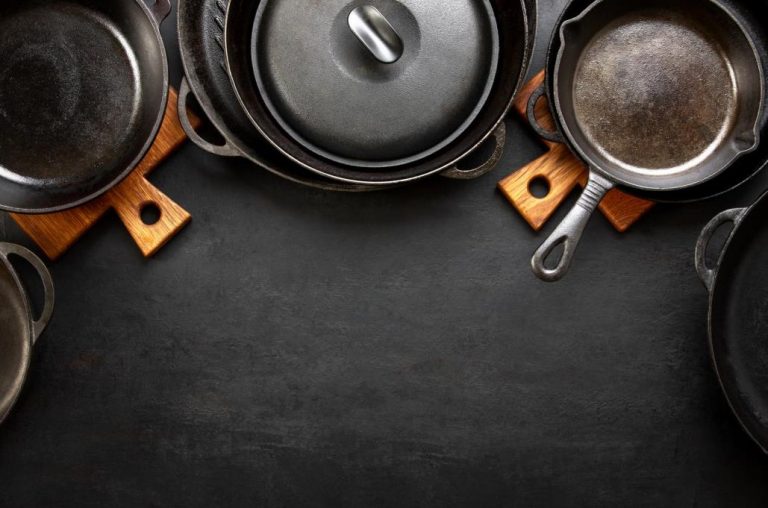The best cookware material differs from person to person. Certain types of materials, such as cast iron and non-stick, tend to receive the most publicity and use. A part of your clientele may favor these or another that delivers them the features they want, but they might not be aware of what the other options provide.
In this article, we will cover the various cookware materials to discover their qualities, examine where each material is best and not so good at, and conclude the best ones for your store.
How to choose the best cookware material?
There is a lot to consider when breaking down the features of any cookware material. User preferences aside, a cookware material’s attributes and requirements determine whether it is good or barely passable. Here is what the shoppers keep in mind when looking for their next cookware purchase.
Heating
Heating performance is the first thing many cooks consider. There are two outlooks as to heating:
- Heat retention: The cookware’s ability to retain heat.
- Thermal conductivity: The rate at which the heat passes through the cookware. In other words, the ability to carry heat.
Any cook will benefit from a cookware material that heats evenly and retains it. You will want to have these in your cookware to brown the exterior and cook the inside of foods.
As a general rule of thumb, the thicker the cookware, the better the heat retention and thermal conductivity. Although the increased weight can be a drawback, an evenly heated cooking surface that retains its hot temperature is worth overlooking.
Nonetheless, different cookware materials have ranging abilities in heat retention and thermal conductivity. Cast iron and enameled cast iron are notoriously known for retaining heat well – the reason why they are such favorites for searing steak.
Copper and stainless steel are also examples of cookware with great thermal conductivity. They heat up pretty fast but can’t retain a hot surface as long – more on how each cookware material compares below.
Buy Wholesale Cookware and Start Scaling up with Us Today
Contact us and connect with a sales rep to get a free quote.
Safety

Like any other kitchen product, the cookware needs to have a safe relationship with the foods we cook. All cookware materials release some chemicals during cooking. Considering a pan can reach over 600 Fº while cooking, metals are bound to release chemicals.
The important part is that these chemicals aren’t harmful to humans or the foods we cook. Some metals are more reactive than others, and a few cookware materials can impart a metallic taste to foods, such as cast iron and aluminum.
All cookware materials we will list in this article are food safe, including aluminum, despite getting a bad rep due to allegedly causing Alzheimer’s. If you come across customers concerned about the chemicals released during cooking, you can guide them toward the clad stainless steel products. It makes the safest cookware with its non-reactive surface, but it isn’t for people with nickel allergies.
Durability
The lifespan of cookware depends largely on the material, the care it gets, and its use frequency. Most expect to get between five and ten years from their newly bought cookware.
Cast iron, enameled cast iron, clad stainless steel, and carbon steel are known for their durability. Cast iron and carbon steel cookware demand much more care from the others, but they can last a lifetime when provided. The same applies to enameled cast iron and clad stainless steel cookware but with lesser needs of care.
Another one that can last for decades is copper. The downside is that it needs to be polished about two times a year and is costly. On the other end of the spectrum, there is non-stick cookware. These can get easily scratched and fall apart following robust or faulty use. Most cooks get less than three years out of non-stick cookware.
Maintenance
Every cookware material requires at least a degree of maintenance. Some need attentive care, like cast iron skillets, to maintain their non-stick seasoning, while others require little to nothing, like non-stick cookware.
If maintenance is a top priority for your customers, they are likely in favor of non-stick, clad stainless steel, or enameled cast iron cookware more than the others. It’s mostly home cooks that tend to favor low-maintenance cookware.
Those who cook for a living care more about the heating and durability of the cookware to get the best results, not what the cookware requires to have it. Even though the care needs of some cookware materials are a tad bit overwhelming to home cooks, professionals see it as a part of a routine.
Stovetop compatibility

The kitchens with conventional gas or electric stovetops don’t have much to be concerned with the cookware material. Any cookware material works perfectly fine with these types of stovetops.
It’s the induction cooktops that don’t work with all cookware materials. They require the cookware to be magnetic to pass the electric current that produces heat. Cast iron, most clad stainless steel, enameled cast iron, and carbon steel cookware work with induction stovetops. These are the standard for induction stovetops.
Other than the cookware materials mentioned above, aluminum and copper can also work with induction stovetops if they have a magnetic base. The stovetop type is only a consideration if it relies on induction cooking.
Budget
You can present a customer with the best cookware with everything they want and need, but if the price is too much, it won’t make the best one after all. The material determines the cost of the cookware. Ultimately, it also affects how much your customers are willing to pay for their cookware.
Copper, clad stainless steel, and enameled cast iron are among the most expensive cookware materials. Cast iron, carbon steel, and aluminum are the least costly, with non-stick cookware being the most affordable.
The price budget changes from consumer to consumer. The more they intend to use the cookware, the bigger the budget – usually. It’s good to have a variety of cookware materials to offer alternatives to customers. This way, you’ll be able to present more options to customers with a tight budget and appeal to more people. Offer cast iron to those who find enameled cast iron expensive, for example.
Best cookware materials
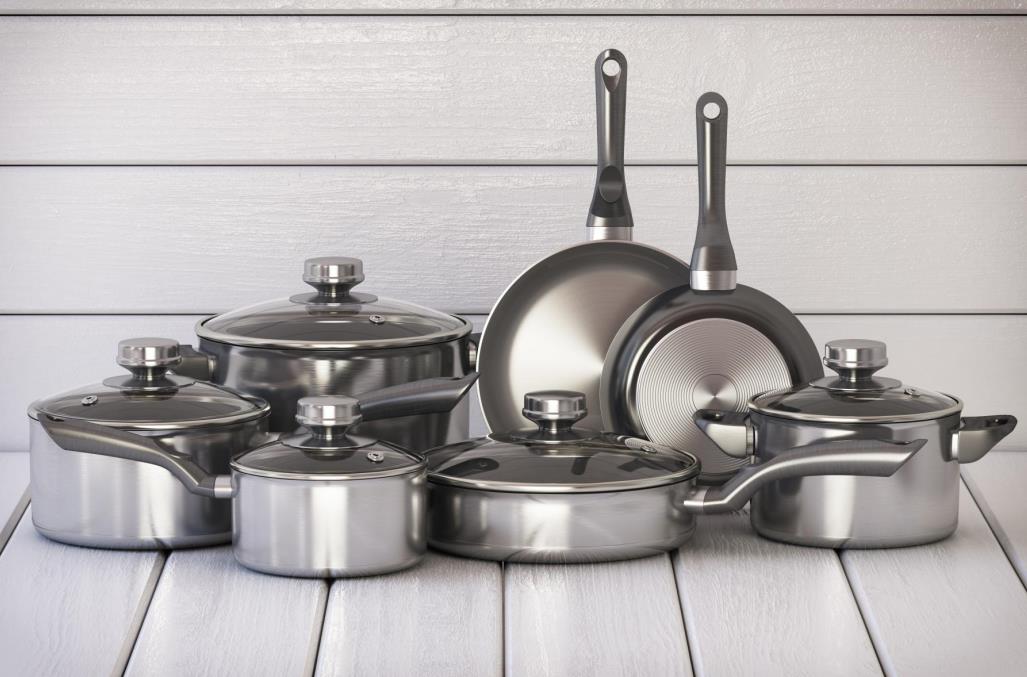
All these remarks bring us to the cookware materials. Here is a detailed breakdown of different cookware materials considering everything shoppers keep in mind.
Clad stainless steel
Clad stainless steel cookware has a stainless steel base and surface with another alloying metal in the inner layer, usually aluminum. The most expensive ones you’ll see in the market are with a copper core. The stainless steel surface of this cookware is non-reactive. It doesn’t add a metallic taste to foods. This feature makes clad stainless steel pans and pots perfect for cooking acidic foods.
This type of cookware is favored by both home and commercial kitchens. It’s lightweight, holds heat well, heats up fairly fast, and can be used for all types of cooking. These come with the downsides of having a high price tag and sticking at times. Foods can easily stick if the surface isn’t heated to the right temperature.
To prevent this from happening, cooks need to bring the temperature up and add a few drops of water to test. If it sizzles and glides over the pan, it’s ready.
Pros
- It has a non-reactive surface, perfect for acidic foods and those concerned about the chemicals cookware emits.
- A highly durable cookware material, clad stainless steel can last for decades with upkeep.
- It has even heat distribution and retains its hot surface.
Cons
- It can get scratched easily.
- It’s usually expensive, especially high-quality ones.
- The cookware can get burned when exposed to prolonged high temperatures.
Cast iron cookware
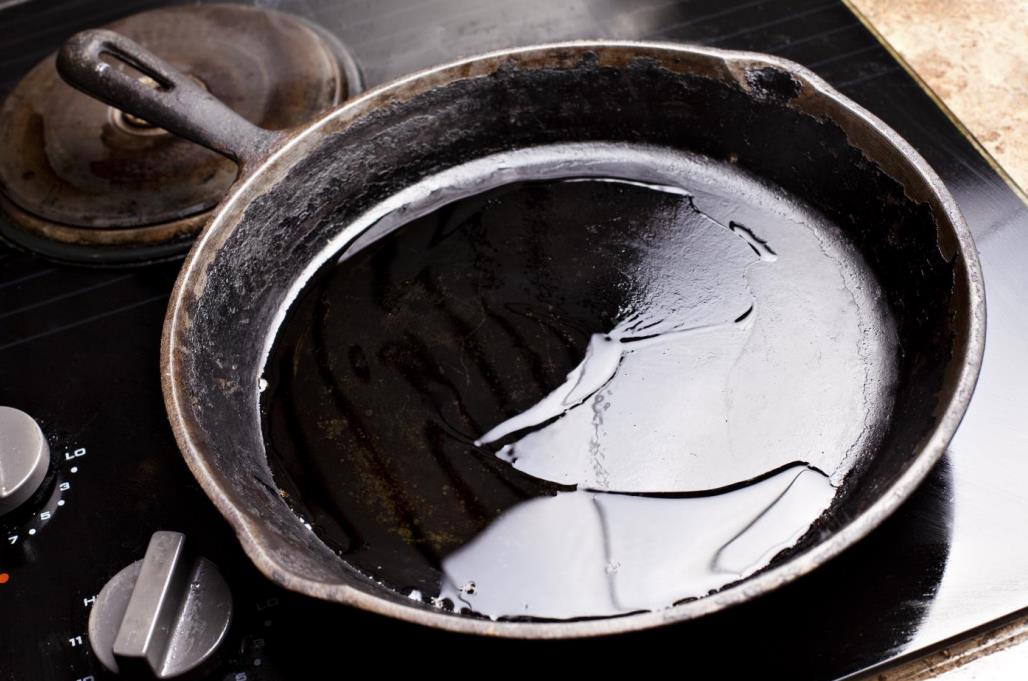
Cast iron is the simplest form of cookware. It can have non-stick attributes with a seasoned surface. Maintaining the seasoning also prevents rust, making it last forever. It can take some time to heat cast iron, but once it gets there, it stays hot. This feature is why many favor cast iron skillets for searing and browning foods. Cast iron cookware, including skillets, can also be used in the oven to bake goods.
Cast iron cookware is affordable, whether in the form of a skillet or a pot. You can have sufficiently sized cast iron skillets that go for $30 to $40 in your store that bring consistent revenue. It is a cookware material that’s preferred by professional and home chefs alike.
These qualities of cast iron come with a few downsides worth mentioning. It requires close care from the user to keep its seasoned, non-stick surface. The upkeep needs, along with a heavy build and acidic foods stripping the seasoning, can be a burden for some. If these are major downsides, the enameled version can be the best alternative to cast iron.
Pros
- Cast iron has amazing heat retention and a naturally non-stick surface.
- CA maintained cast iron lasts as long as the cook.
- The abilities of cast iron come with an affordable price tag that fits every customer’s budget.
Cons
- Cooking with acidic foods can scrape off the seasoning, requiring the cook to reseason right away to prevent foods from sticking.
- It takes time to heat cast iron cookware – not the best for cooking midnight snacks.
- Cast iron needs care. Cooks must reseason the surface regularly and take a rather different cleaning approach.
- It’s heavy – carrying it around the kitchen can get cumbersome.
Buy Wholesale Cookware and Start Scaling up with Us Today
Contact us and connect with a sales rep to get a free quote.
Carbon steel cookware
Carbon steel cookware is similar to cast iron. They are very similar materials, but carbon steel actually has less carbon than cast iron. Carbon steel cookware has less than one percent carbon in the composition, whereas cast iron has over two percent.
Unlike cast iron, carbon steel cookware is made by cutting or stamping the metal into the desired shape. As you can expect, carbon steel cookware is lightweight and somewhat flexible. Depending on the surface-hardening treatments, it can have a shiny silver or a bluish color.
Carbon steel pots and pans must be seasoned, and acidic foods can damage them. They are best for slow-cooking foods over low heat or searing at high temperatures. Carbon steel cookware is the best alternative to cast iron if the weight is why a customer looks elsewhere. It’s also a good option for those that want a non-stick cooking surface but are tired of replacing their non-stick cookware.
Pros
- Affordable pricing – most carbon steel skillets go for less than $50.
- Nontoxic, naturally non-stick surface with seasoning that upholds to scratches, even against metal utensils.
- It heats up quickly and retains a hot surface.
Cons
- It reacts to acidic foods. When cooked, carbon steel loses its non-stick capabilities slowly.
- Carbon steel cookware heats up fast, but due to its thin build, it can’t retain it for long.
- The slender design also leads to uneven heat distribution.
Enameled cast iron cookware
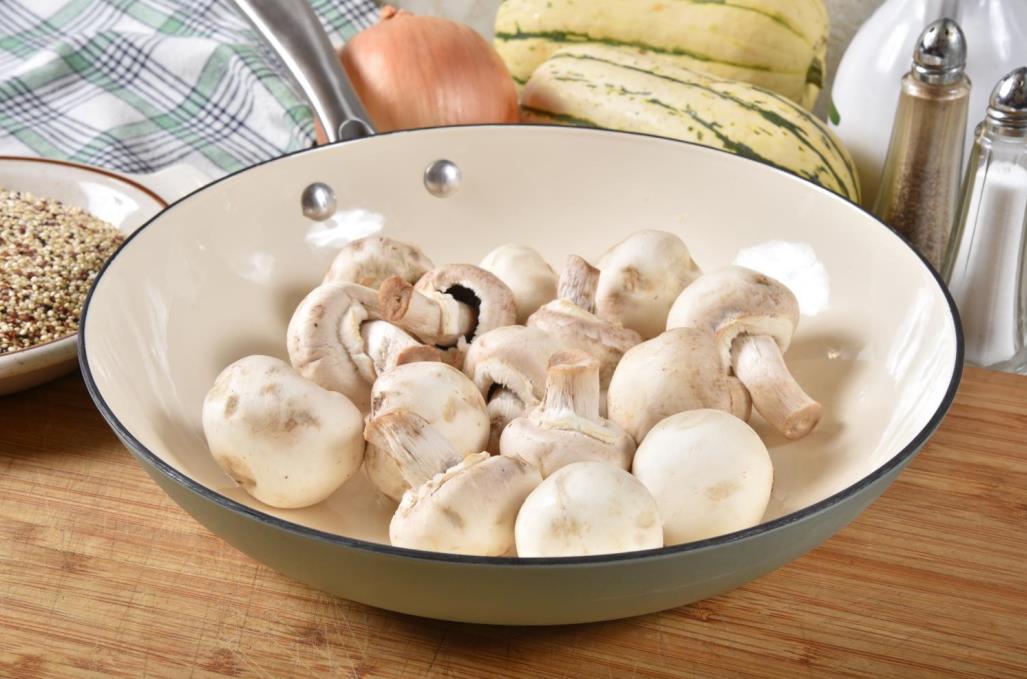
Enameled cast iron and cast iron doesn’t have much difference. It’s the same as regular cast iron but with a vitreous coating that protects it against rust. It also gives it non-stick abilities but not always. Enameled cast iron needs oil or other liquids to prevent foods from sticking. The coating can be in various colors, from gray to blue.
The best feature of enameled cast iron is that it doesn’t require seasoning. Cooks can use it immediately and clean the surface with soapy water. It has excellent heat retention, on par with regular cast iron. However, cooking at high temperatures declines the coating slowly, which can lead to sticking. It also heats up not as evenly as cast iron.
Enameled cast iron is prevalent in all types of cookware. You can find pots, pans, skillets, and Dutch ovens made from enameled cast iron. Although it costs more than cast iron, it brings similar features with lower maintenance needs.
Pros
- It has amazing heat retention, perfect for braising and stewing.
- Enameled cast iron is one of the most durable cookware.
- The surface is partially non-stick and doesn’t require any seasoning.
- It’s easy to care for – rusting, cracks, or warps aren’t apparent.
Cons
- Enameled cast iron is not cheap. It costs a lot more than the other cookware materials mentioned so far.
- The coating is quite fragile. Using metal utensils or vigorous use can scrape it off.
- Enameled cast iron is heavy and heats up slower than cast iron due to the vitreous coating.
Copper cookware
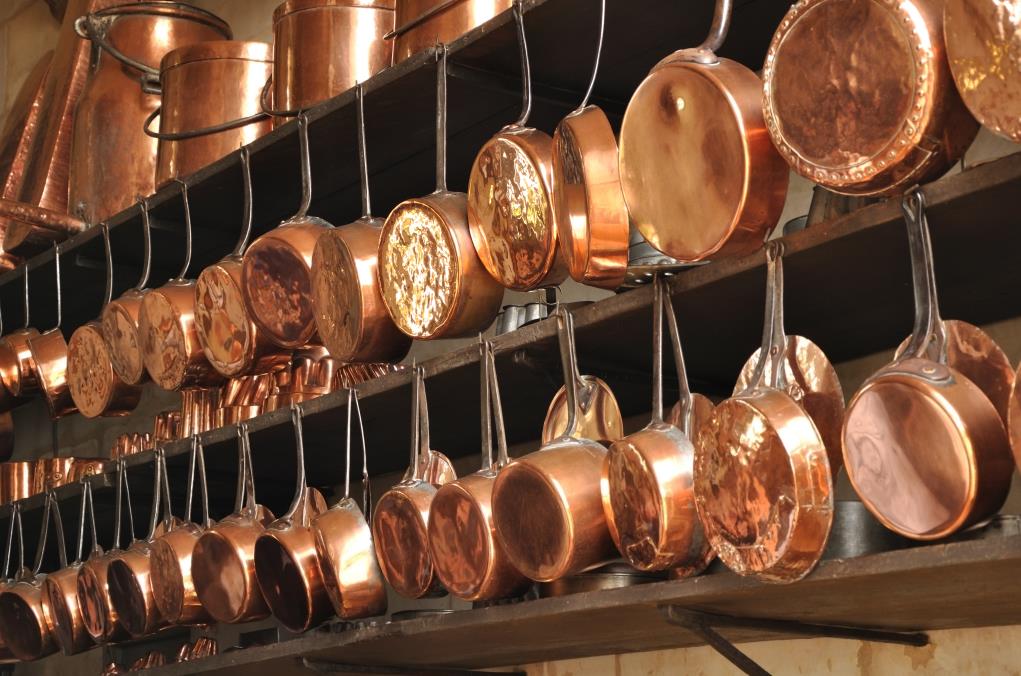
Most copper cookware isn’t entirely made from copper. Many have a copper base with a steel, ceramic, or tin cooking surface. The ones coated with tin should never be used over high temperatures as it has a low melting point at 450 Fº. Copper gets used in cookware because it has excellent heat conductivity and corrosion resistance. It heats up fast and evenly, giving the cooks a perfect surface to cook.
Copper cookware without coating is a favorite among pastry chefs for jam and syrup. However, they must be used carefully. Otherwise, copper can leach into foods, which aren’t safe to consume. The copper pots and pans with a ceramic coating are ideal for many types of cooking but are fragile. They are best for soups and sauces. The sturdiest are with steel coating. Most also have a ferromagnetic coat at the bottom for induction cooktops.
Copper cookware is in a niche category, so it isn’t for everyone. Copper needs polishing at least twice a year and is costly, much over enameled cast iron and others.
Pros
- Copper cookware can’t be used over high heat. It’s best for cooking at medium to low heat.
- The thermal conductivity and heat retention on low heat makes copper cookware excellent for making sauces and melting foods.
- Copper cookware is long-lasting. It will serve users for years, whether with tin, ceramic, steel coating, or none.
Cons
- Although a durable cookware material, it must be polished throughout the year to remove the dark patina.
- Copper cookware is the most expensive. A standard-sized pot can run your customers up to $200.
Aluminum cookware
Aluminum is an excellent heat conductor. It heats up quickly and evenly. Following proper use, aluminum cookware can last for years. Cooks can use aluminum cookware for all types of cooking. However, it can impart a metallic taste to foods as it’s reactive, particularly with acidic foods.
There isn’t just one aluminum cookware, though. It has anodized and standard versions. With anodized aluminum cookware, the metal is sealed so it can’t discharge into foods. It’s also non-stick in most cases. The non-coated aluminum cookware’s surface is just aluminum; it can release some into the food. Like cast iron, it also needs to be seasoned. If this raises concerns, anodized aluminum cookware is better to get the aluminum’s heat conductivity and retention.
Aluminum as a material has the best heat retention. An aluminum pot or pan with the same thickness as cast iron will retain its heat better. There isn’t as much cookware with a similar build because of the price. That and its durability is why it’s mostly restaurants that pick aluminum cookware.
Pros
- Aluminum cookware heats up fast and evenly and maintains its hotness for a long time.
- It’s a durable cookware material – just not as much as cast iron or carbon steel.
- Aluminum cookware is one of the lightest – even the handle might weigh more.
Cons
- Aluminum is fairly soft. If it’s non-coated, the surface is susceptible to scratches.
- It’s reactive, so cooking with acidic foods can transmit a metallic taste.
Non-stick cookware

Non-stick cookware has been at the center of attention for many years. It makes convenient cookware that is easy to use and maintain. However, there isn’t only one non-stick cookware material. Many non-stick materials are used for making cookware. Some can emit harmful chemicals over high heat.
For example, PTFE, one of the most commonly used non-stick cookware materials, releases hydrofluoric acid when heated over 660 Fº. Luckily, most non-stick pans don’t contain this synthetic fluoropolymer anymore. Most non-stick cookware in the market is safe, but using them over high heat isn’t recommended. The surface can quickly lose its known capabilities.
Non-stick cookware is convenient, with easy cleaning and a surface that prevents sticking. However, convenience doesn’t always mean quality. Durability, not being able to use over high heat, and the controversial health concerns bring non-stick cookware down.
Pros
- It has a fully non-stick surface.
- Non-stick cookware is easy to wash and dries quickly.
- It’s so affordable that won’t stretch any cook’s budget.
Cons
- Non-stick isn’t ideal for everything – it’s best for pans, not so much for pots.
- Cooking over high heat using non-stick cookware reduces its non-stick abilities and may raise safety concerns.
Comparison table
| Heating | Safety | Durability | Maintenance | Stovetop compatibility | Cost | |
| Clad stainless steel | Good heat retention and conductivity | Non-reactive, doesn’t emit chemicals | Highly durable | Easy to maintain | Most work with all, including induction cooktops | Mid-range to expensive |
| Cast iron | Excellent heat retention – poor conductivity | Reacts with acidic foods but safe | Lasts forever | Close care needed | Works with all | Affordable |
| Carbon steel | Excellent heat retention – poor conductivity | Reacts with acidic foods but safe | Highly durable | Close care needed | Works with all | Affordable |
| Enameled cast iron | Good heat retention – poor conductivity | Non-reactive, doesn’t emit chemicals | Highly durable | Easy to maintain | Works with all but not so good over an open fire | Expensive |
| Copper | Good heat retention – excellent conductivity | Generally safe without coating – coated ones are non-toxic | Highly durable | Care needed – needs polishing | Requires a magnetic base for induction cooking | Very expensive |
| Aluminum | Good heat retention – excellent heat conductivity | Generally safe without coating, anodized versions are non-toxic | Durable | Requires some care | Requires a magnetic base for induction cooking | Affordable to mid-range |
| Non-stick | Poor heat retention – good conductivity | Generally safe below high heat | Not durable | Effortless to maintain | Works with most, not recommended for open fires | Cheap |
Tips on choosing the best cookware to sell
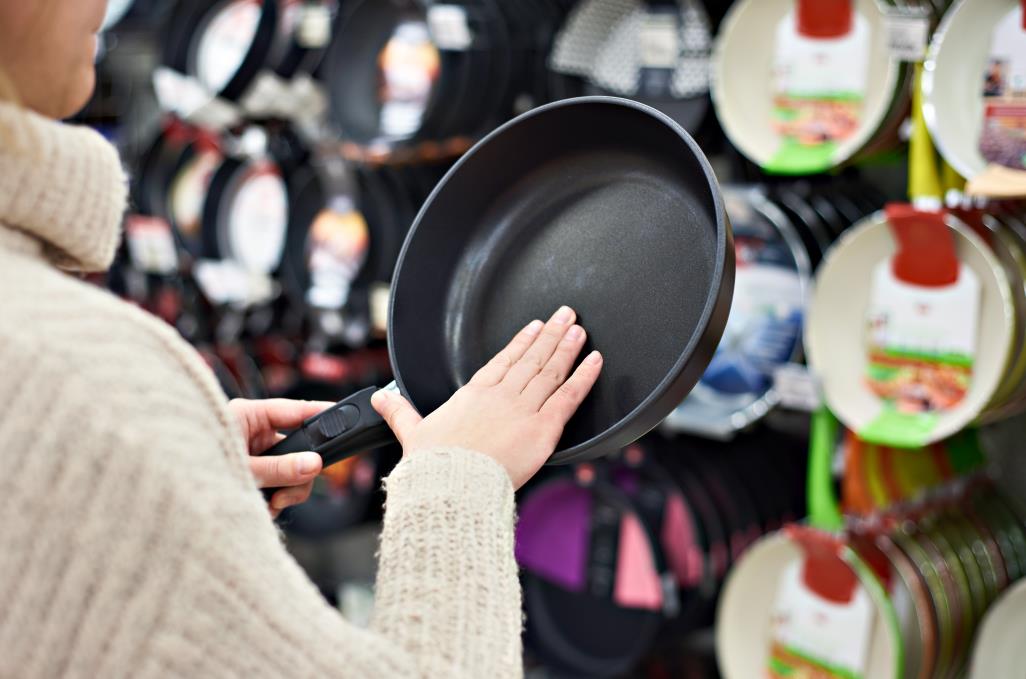
Here are a few bullet points to help you choose the right cookware to sell in your store.
- Your inventory: What cookware do you already have in stock? How is your success with the existing products? Maybe it’s time to try something entirely new. Look for cookware materials you haven’t sold and do product test runs to measure their performance.
- Consider your area: Is your store located in a metropolitan city or on the outskirts? People who camp often need something they can cook over an open fire, which eliminates non-stick and enameled cast iron. A strong online presence is the best way to expand your reach beyond the limitations of a brick-and-mortar store.
- Compatibility: Not all cookware work with induction cooktops. Cookware with a slight bend at the bottom designed for gas stovetops doesn’t always make full contact with electric stovetops. Consider the types of stovetops your customers utilize and the compatibility of the cookware you sell.
- Prices: Various cookware materials have ranging prices. Not everyone is willing to spend $50 on a pan or skillet, even though it is well below average for a high-quality product. Sell cookware with a diverse range of prices to offer alternatives to customers that have a limited budget.
- User preferences: In kitchen products, user preferences are everything. Every cook has their likings and dislikings. Conducting surveys and engaging in conversations to see what your customers like converts more than you can imagine. From there, you can customize the products you sell to deliver the best cookware.
Buy Wholesale Cookware and Start Scaling up with Us Today
Contact us and connect with a sales rep to get a free quote.
Final words
With this many cookware materials, there are undoubtedly a few that suit your customers perfectly. While some are more popular than others, many perfect cookware materials fly under many users’ radars. Introducing new cookware materials and explaining their features to customers might just make you their favorite store in town. Consider bookmarking this page before you leave to create a checklist when you’re ready to order new cookware to sell.
LeeKnives is a knife manufacturer with a wide range of wholesale kitchen products. We can supply you with all the products you need, catered directly to your customers. Feel free to request a quote for our wholesale, OEM, and private label services.
